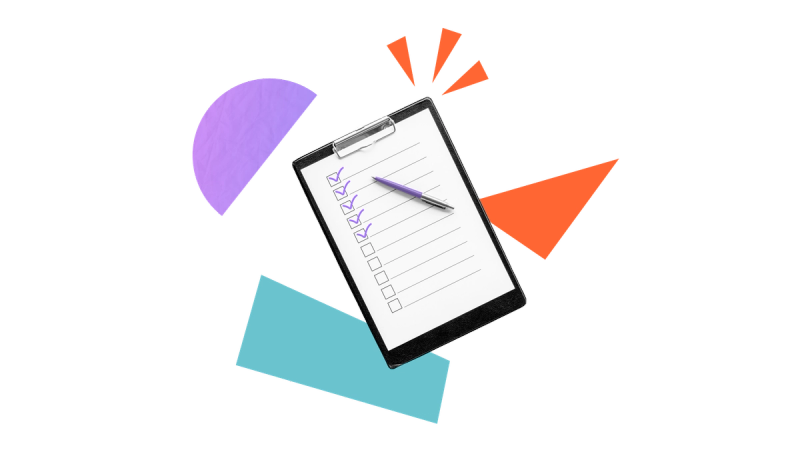5 surveys every successful company should use
Share on socials
5 surveys every successful company should use

Jump to Section
Jump to section
1. New hire survey
2. Employee satisfaction survey
3. Training evaluation/onboarding survey
4. Event evaluation survey
5. Exit interview survey
Want to create a survey that gets results? Discover five essential form types for your business and tips to get started.
Not every survey is created the same. To make sure you get the right answers, you need to tailor your survey for your needs. Read on and we’ll explore five popular survey types you should be using in your company.
If you want to get started quicker, you can read our guide to creating forms and surveys in Confluence.
If you want to get started quicker, you can read our guide to creating forms and surveys in Confluence.
1. New hire survey
It’s expensive to hire new employees, so you need a new hire survey. You can explore the good, the bad, and the ugly about joining your business, especially if early employee churn is an issue for you.
Sometimes, this survey gets blended in with an onboarding guide, but it’s great to treat them as two areas (joining the business and working in the business) for thorough investigation. Are there improvements that a new hire could identify for you with your application process, response times, or the tasks you set? How does your recruitment process compare to competitors?
Sometimes, this survey gets blended in with an onboarding guide, but it’s great to treat them as two areas (joining the business and working in the business) for thorough investigation. Are there improvements that a new hire could identify for you with your application process, response times, or the tasks you set? How does your recruitment process compare to competitors?
Questions to ask in a new hire survey:
Use a mix of question types to acquire qualitative and quantitative data. As well as simple yes/no questions and ratings, use a free-form text box to try to bring the information to life.
Here are some questions to consider:
Here are some questions to consider:
- How would you rate our recruitment process (Great, Good, Okay, Average, Poor) and why?
- How would you rate our interview process (Great, Good, Okay, Average, Poor) and why?
- Where did you research the business before your interview?
- How would you describe our response times during the interview process?
- How would you describe our methods of application and our feedback channels?
- What were the reasons for choosing the business?
- Do you have any additional comments?
Tip: How to create a survey for new hires
Our tip when running a new hire survey is to consider breaking it down into multiple questionnaires. We’ve focused on recruitment here, but you might want to dig into team culture, communication, or even technical support and set-up.
2. Employee satisfaction survey
An employee satisfaction survey enables you to determine whether employees are satisfied with the work environment and if they are enthusiastic and committed to the company, how they feel about the company, and if they can identify the business goals, culture, or direction.
Questions to ask in an employee satisfaction survey:
An employee satisfaction survey can be broken into smaller mini-surveys that tackle different areas of the employee experience, or you can ask succinct questions to gauge overall satisfaction without as much depth.
Here are some questions to consider:
Here are some questions to consider:
- Do you understand the company's vision?
- Do you understand your role?
- Have you been given the resources and training for your role?
- How often do you receive manager recognition?
- Would you recommend this business to family or friends?
- Do you feel engaged in your work?
- Please can you share your view on how we can improve the employee experience?
Tip: How to create a survey for employee satisfaction
Make your survey anonymous if you can, as responses are more likely to be genuine and helpful. A scared employee, who worries they will be ‘marked down’ for saying the wrong thing won’t speak truthfully, will make your data unreliable at best, or redundant at worst.
Read more: 6 essential questions for an employee engagement survey
Read more: 6 essential questions for an employee engagement survey
3. Training evaluation/onboarding survey
A training evaluation survey enables your employees to provide feedback on your company training programs or processes.
Training evaluation (which can be included in an onboarding survey) helps you understand the time it takes to transform an employee from a total newbie to someone valuable and productive. Understanding this can be key to reducing time scales, identifying team members critical for effective onboarding, or changing your delivery methods.
Training evaluation (which can be included in an onboarding survey) helps you understand the time it takes to transform an employee from a total newbie to someone valuable and productive. Understanding this can be key to reducing time scales, identifying team members critical for effective onboarding, or changing your delivery methods.
Questions to ask in a training evaluation/onboarding survey:
Here are some questions to consider:
- How was your overall experience during onboarding (Great, Good, Okay, Average, Poor) and why?
- Please share any highlights of the onboarding process. (Free-form text box)
- How would you rate the resources provided during onboarding (Great, Good, Okay, Average, Poor) and please share additional comments for improvement/change?
- Please can you describe the culture/company values as you understand them? (Free-form text box)
- Which of these are the company values? (Checklist)
- Can you identify any stand-out team members during your training and share how they made the experience for you?
- Please rate your training expectations versus reality (Exceeded Expectations, Met Expectations, Beneath Expectations).
Tip: How to create a survey for training and onboarding
This can be the easiest employee survey for busy employees to forget to do, so consider making a survey more engaging in the form of a branching scenario! Asking real-life questions about onboarding, such as: ‘You’ve been onboarded. What items did you receive?’, helps you to see what the experience was actually like.
4. Event evaluation survey
An event evaluation survey is for customers and employees. (We love a dual-purpose survey!) Whether you run regular events for employees or for customers and prospects, finding out how your events stack up against expectations is well worth knowing.
Questions to ask in your event evaluation survey:
Here are some questions to consider:
- Would you attend an event like this again?
- Did the event meet your expectations?
- What was a highlight for you from the event?
- What could we do better next time?
Tip: How to create a survey for event evaluation
Send the survey soon after the event so true feelings are fresh in the mind. It can help to diarise or automate your survey so it’s ready to go when you are!
Read more: 5 essential onboarding documents every new hire needs
Read more: 5 essential onboarding documents every new hire needs
5. Exit interview survey
If an employee chooses to leave, you might not always get the real reason why. Even the bravest employee may falter when in a one-on-one interview. A written exit interview survey allows you to gather feedback and helps you identify any areas for improvement and also provides closure for your employee before they leave.
Questions to ask in an exit interview:
Here are some questions to consider:
- Please could you tell us why you are leaving?
- Could we have done anything to make you stay?
- Did you voice any concerns to your manager or leadership team, and were you listened to?
- Did you get enough support from the leadership team in general?
- Did you feel your goals and objectives and routes to success were clear to you?
Tip: How to create a survey for an exit interview
The exit interview survey can provide valuable information on how to improve the work environment and can identify weak links in management, goal setting, or even onboarding.
Be sure to stress that the exit interview will not negatively affect their reference or how they are viewed internally, and that you aren’t attempting to ‘win them back’, or convince them to stay, but that their real feedback could really benefit other team members.
Be sure to stress that the exit interview will not negatively affect their reference or how they are viewed internally, and that you aren’t attempting to ‘win them back’, or convince them to stay, but that their real feedback could really benefit other team members.
Start creating surveys for any occasion
Now you’ve read about all these great surveys, we're sure you’re keen to give them a try. We can’t blame you. Luckily, the easy way to get started is just a few clicks away...
Our intuitive form builder makes creating a form in Confluence quick and easy!
Get your 30-day free trial of Forms for Confluence by clicking the button below.
Related Content
Read moreWritten by

Senior Product Marketing Manager
With more than a decade of expertise in digital and product marketing, Matt serves as a Senior Product Marketing Manager at Kolekti. His passion lies in helping teams effortlessly collect and comprehend user feedback within the Confluence platform.
Related Content
Read more


